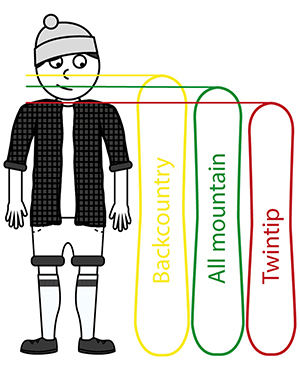Purchasing Snowboards
Your snowboard selection majorly hinges on your skill level and your enthusiasm for riding on the slope, in the park, or off-piste. Key elements to consider include your foot size, body weight, and height.
How to Determine the Ideal Snowboard Length and Width
- Snowboard Length is influenced by your preferred terrain and stature. Generally, your snowboard should range between your shoulder and the midpoint of your head. Longer boards are generally advised for those venturing into backcountry/off-piste, while shorter boards suit freestyle manoeuvres. A board positioned in the middle offers flexibility and is well-suited for all-mountain riding.
For novices and children, it is often suggested to select a slightly shorter board to facilitate an enjoyable snowboarding journey. Size guides are usually available on the individual snowboard product pages, when provided.
Nowadays, brands frequently provide size charts specific to different models, which are based on weight. This is likely the most accurate method for selecting the proper snowboard length. - Snowboard Width is predominantly classified as Standard and Wide. Wide boards are recommended for those with a shoe size of 44 and above. However, this does not apply to junior wide boards.

Exploring Snowboard Variants
- Twintip snowboards are ideal for park and tricks while offering enjoyable rides on the slope. The front and back have an identical design and the bindings are centrally located, making it simple to ride in both directions and execute landings for tricks.
- All-mountain snowboards offer the most versatility. Their structure resembles that of twintip snowboards, but with the bindings, flex, and balance point shifted backwards. This type is an excellent investment for the majority, as it suits all mountain terrains, including slope, park, and off-piste.
- Backcountry: Designed for deep powder rides off-piste. Its shape closely resembles a surfboard, and the extensive surface area provides exceptional movement within deep snow.
Different Snowboard Designs
Shaping Techniques
- Directional: Built to be ridden in just one direction, frequently utilised on the slope or off-piste. This shape features a stiffer structure towards the end, enhancing steadiness at high velocities.
- Twin: Constructed with identical front and back, suitable for parks and tricks. Twin-shaped snowboards can be ridden in either direction.
- Directional Twin: A blend of both shapes, commonly crafted for all-mountain and freestyle snowboards.
Baseline Construction
A snowboard’s baseline (its bottom) varies and may be crafted with camber, rocker, or a flat design. These styles are often merged according to the intended function of the snowboard.

- Rocker: Featured when a snowboard curves upwards at the top and/or end, making it optimal for powder snow and smooth turns. Rocker reduces drag and provides a dependable park board.
- Camber: Both the front and rear of a snowboard are pressed into the snow, expanding the contact region and offering an enhanced edge grip.
- Flat: Ensures total contact with the snow surface, delivering greater steadiness than a traditional rocker and facilitating easy turns.
